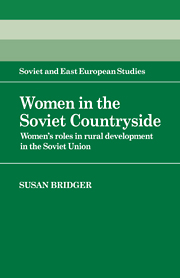Book contents
- Frontmatter
- Contents
- List of figures
- List of tables
- Acknowledgements
- Notes for readers
- Map: the Union republics of the USSR
- Map: the Non-Black Earth Zone of the RSFSR
- INTRODUCTION
- 1 WOMEN IN THE RURAL WORKFORCE
- 2 WOMEN IN THE RURAL FAMILY
- 3 WOMEN'S ROLES IN RURAL CULTURE
- CONCLUSIONS
- Notes
- Bibliography
- Index
1 - WOMEN IN THE RURAL WORKFORCE
Published online by Cambridge University Press: 05 January 2012
- Frontmatter
- Contents
- List of figures
- List of tables
- Acknowledgements
- Notes for readers
- Map: the Union republics of the USSR
- Map: the Non-Black Earth Zone of the RSFSR
- INTRODUCTION
- 1 WOMEN IN THE RURAL WORKFORCE
- 2 WOMEN IN THE RURAL FAMILY
- 3 WOMEN'S ROLES IN RURAL CULTURE
- CONCLUSIONS
- Notes
- Bibliography
- Index
Summary
THE EFFECT OF MIGRATION
In 1960 51% of the Soviet population lived in rural areas. Twenty years later the rural share of the population had fallen to 37%. By the latter half of the 1960s out-migration from the villages had become greater than the natural growth rate of the rural population. As a result, the rural population began to decline in absolute terms. Though the rural birthrate remained higher than that in the towns, the rural population fell from 109 million in 1959 to 98 million in 1980. In the same period the urban population increased from 100 million to 166 million.
Far from being a universal phenomenon, however, the decline in the rural population was experienced only in the most developed regions of the USSR. Between 1959 and 1970 out-migration was at its most intense in the central region of the Non-Black Earth Zone, with Western and parts of Eastern Siberia also experiencing a significant decline in rural population. During the 1970s a high level of outmigration continued to be characteristic of the Non-Black Earth Zone, as Figure I illustrates. In this same period, however, rural population decline intensified in Belorussia, the Ukraine and regions of the Volga and Urals areas. In addition, rural population decline was experienced for the first time in Northern Kazakhstan.
In the course of these two decades rural population increased in Central Asia, Kazakhstan and much of the Caucasus.
- Type
- Chapter
- Information
- Women in the Soviet CountrysideWomen's Roles in Rural Development in the Soviet Union, pp. 21 - 88Publisher: Cambridge University PressPrint publication year: 1987

